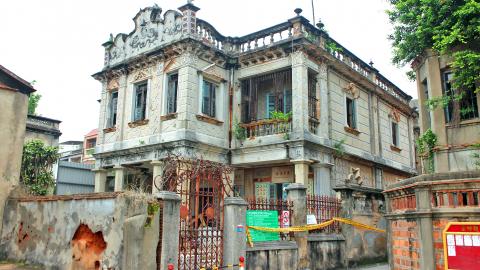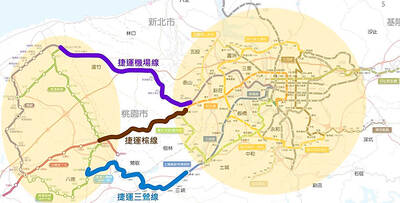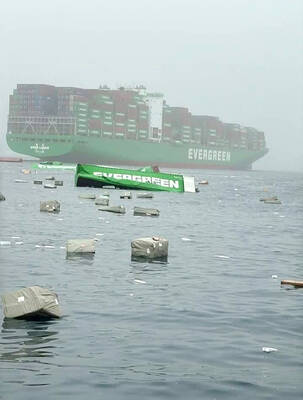While Kinmen County is primarily known for its production of the strong spirit called kaoliang, the county is also home to many townhouses built in the mid-20th century in a particular mix of Chinese and Western styles, two of which are being renovated to maintain the buildings in light of the architectural style’s significance in the county’s development over the years.
In the mid-19th century, many coastal residents in China, as well as in Kinmen, had turned to the comparatively prosperous Malaysian Peninsula, Philippine islands and Indonesia to make their fortunes.
After prospering in the region and coming under the influence of local architectural styles, some Kinmen residents remitted money to be used building Western-style townhouses, with certain aspects of Chinese-style architecture mixed in, while they remained abroad.

Photo: CNA
According to the Kinmen County Bureau of Cultural Affairs, the county boasts 161 townhouses that are built with the unique hybrid style, but many of the houses are owned by foreigners — the descendants of former Kinmen residents who have settled abroad — and have fallen into disrepair.
The two buildings under renovation belonged to Chen Shih-yin’s (陳詩吟) family in Houpu District (後浦) and Tung Yun-yao’s (董允耀) family in Gugang District (古崗), the bureau said.
The Chen townhouse was built in 1933 and designated a county-level heritage site in 2006. Located directly beside the Kueising Tower (魁星樓) in the South Gate area, the townhouse is considered an important cultural asset by the county, the bureau said, adding that it is undertaking emergency repairs — including repairing a caved-in roof and clearing vines from the facade — after years of disrepair.
The Tung family townhouse, also built in 1933, was designed in Singapore and built by locals, the bureau said, adding that it was designated a county-level heritage site in February last year.
Like the Chen family townhouse, its roof has caved in.
The bureau said that the Chen house is to be repurposed into a coffee house once repairs have been completed, adding that it contracted academic Chiang Po-wei (江柏煒) in 2008 to research how to best restore the townhouse to its original state.
The Tung townhouse consulted National Quemoy University department of architecture professor Tseng Yi-jen (曾逸仁) for the repairs and restoration project, adding that the bureau plans to repurpose the townhouse into a workshop and exhibition site for Tung Teng-hsiang (董騰祥), who crafts traditional lanterns called bride’s lamps (新娘燈).
Tung Teng-hsiang is not related to Tung Yun-yao’s family, but the families live in close proximity to each other.
Meanwhile, bureau director Lu Kun-ho (呂坤和) said the bureau decided to step in to prevent further damage from rainwater and has set up a temporary scaffolding around to building to shelter it from the elements.

“China is preparing to invade Taiwan,” Deputy Minister of Foreign Affairs Francois Wu (吳志中) said in an exclusive interview with British media channel Sky News for a special report titled, “Is Taiwan ready for a Chinese invasion?” the Ministry of Foreign Affairs said today in a statement. The 25-minute-long special report by Helen Ann-Smith released yesterday saw Sky News travel to Penghu, Taoyuan and Taipei to discuss the possibility of a Chinese invasion and how Taiwan is preparing for an attack. The film observed emergency response drills, interviewed baseball fans at the Taipei Dome on their views of US President

ECONOMIC BENEFITS: The imports from Belize would replace those from Honduras, whose shrimp exports have dropped 67 percent since cutting ties in 2023 Maintaining ties with Taiwan has economic benefits, Ministry of Foreign Affairs officials said yesterday, citing the approval of frozen whiteleg shrimp imports from Belize by the Food and Drug Administration (FDA) as an example. The FDA on Wednesday approved the tariff-free imports from Belize after the whiteleg shrimp passed the Systematic Inspection of Imported Food, which would continue to boost mutual trade, the ministry said. Taiwan’s annual consumption of whiteleg shrimps stands at 30,000 tonnes, far exceeding domestic production, the ministry said. Taiwan used to fill the gap by importing shrimps from Honduras, but purchases slumped after Tegucigalpa severed diplomatic ties with Taiwan

The Executive Yuan yesterday approved a southwestern extension of the Sanying MRT Line from New Taipei to Bade District (八德) in Taoyuan, with a goal of starting construction by late 2026. The 4.03-kilometer extension, featuring three new stations, will run from the current terminus at Yingtao Fude Station (LB12) in New Taipei City to Dannan Station (LB14), where it will connect with Taoyuan’s Green Line, New Taipei City Metro Corp said in a statement. This extension will follow the completion of core Sanying Line, a 14.29-kilometer medium-capacity system linking Tucheng (土城), Sansia (三峽)

CARGO LOSS: About 50 containers at the stern of the ‘Ever Lunar’ cargo ship went overboard, prompting the temporary closure of the port and disrupting operations Evergreen Marine Corp, Taiwan’s largest container shipper, yesterday said that all crew members aboard the Ever Lunar (長月) were safe after dozens of containers fell overboard off the coast of Peru the previous day. The incident occurred at 9:40am on Friday as the Ever Lunar was anchored and waiting to enter the Port of Callao when it suddenly experienced severe rolling, Evergreen said in a statement. The rolling, which caused the containers to fall, might have been caused by factors including a tsunami triggered by an earthquake in Russia, poor winter sea conditions in South America or a sudden influx of waves,